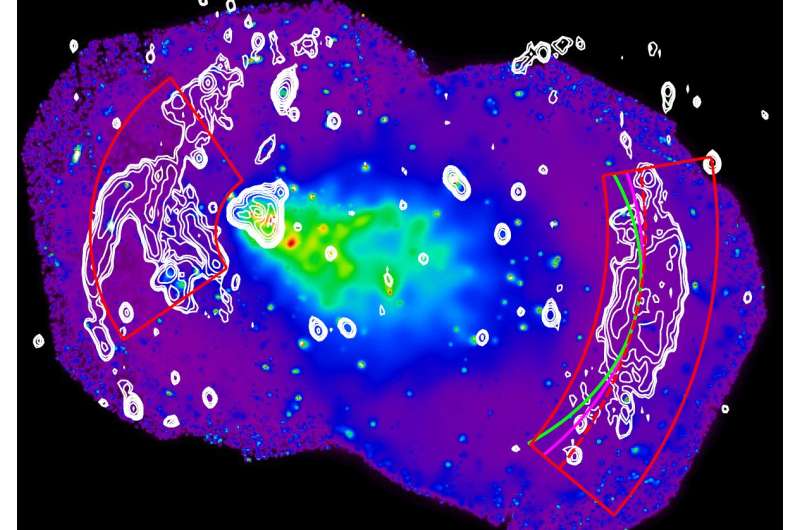Merging galaxy cluster provides laboratory for accelerating electrons

Merging galaxy clusters provide natural laboratories for astronomers to study cosmic phenomena. Igone Urdampilleta from SRON Netherlands Institute for Space Research uses the merger Abell 3376 to study how electrons rush through the intracluster medium at relativistic speeds. The findings point towards an acceleration mechanism called Diffusive Shock Acceleration. The study is published in Astronomy & Astrophysics.
Currently, the Milky Way is on collision course with the Andromeda Galaxy at a speed of over 100 kilometers per second. Will the sun violently collide with one of the trillion Andromeda stars, taking the Earth down with her? Fortunately, no. The distances between stars in a galaxy are so vast that if they were the size of ping pong balls, they would be about 1000 kilometers apart. Galaxies don't collide, they merge. The same goes for clusters of galaxies. They provide astronomers with a cosmic laboratory for studying all kinds of phenomena, such as electrons accelerating through the gas in between galaxies. Igone Urdampilleta from SRON Netherlands Institute for Space Research uses two merging clusters, who share the name Abell 3376, to study how electrons get accelerated up to relativistic energies.
During the merger, hot and diffuse gas between galaxies heats up and becomes turbulent. Astronomers call this the intracluster medium (ICM), which is extremely airy, containing just one particle per liter. The 'collision' causes shock fronts, propagating from the center to the outskirts of the cluster. Because the ICM becomes hot, Udrampilleta was able to observe it via X-rays using the XIS instrument on the Japanese Suzaku space telescope.
Urdampilleta and her colleagues compared their X-ray observations on shock fronts in the outskirts of Abell 3376 with radio measurements in that same region. In the periphery, shock fronts are usually associated with radio emissions either due to direct acceleration of electrons—called diffusive shock acceleration—or due to re-acceleration of pre-existing cosmic ray electrons. The researchers conclude that at least in the case of the Western radio relic of Abell 3376, the electron acceleration mechanism seems to be consistent with diffusive shock acceleration.
More information: I. Urdampilleta, H.Akamatsu, F. Mernier, J. S. Kaastra, J. de Plaa, T. Ohashi, Y. Ishisaki, and H. Kawahara, 'X-ray study of the double radio relic Abell 3376 with Suzaku', Astronomy & Astrophysics, www.aanda.org/articles/aa/abs/ … 6-17/aa32496-17.html
Journal information: Astronomy & Astrophysics
Provided by SRON Netherlands Institute for Space Research




















